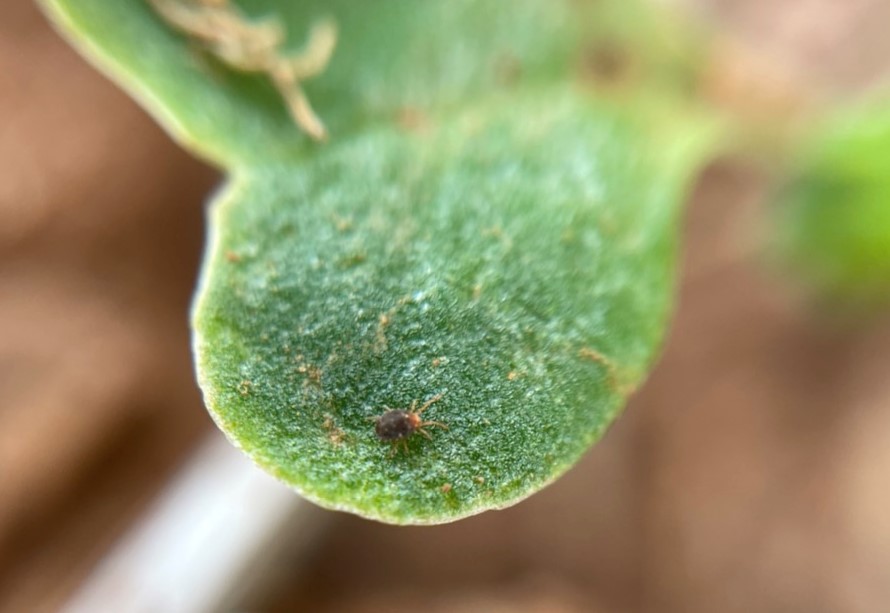There are multiple species of Bryobia mites in Australia, but they are difficult to tell apart using morphological characteristics. Correct identification of the different species is important for management decisions because the species have different distributions, host preferences and, importantly, chemical sensitivity.
In this article we report on the current Bryobia mite situation within Victoria and give a research update on the distribution and chemical sensitivity of the different Bryobia species in Australia.
Current reports from south-eastern Australia
Bryobia mites are widespread across Australia and tend to cause most damage during crop establishment in autumn, especially to broadleaf crops and pastures.
For more information on Bryobia mite description and lifecycle see our Pestnotes.
Activity of Bryobia mites was predicted to be high this season due to warm autumn temperatures and the presence of ample green bridges over summer in many parts of south-eastern Australia.
Although Cesar Australia staff have noticed quite a few Bryobia mites around, we haven’t seen population numbers high enough to reach damaging levels.
We have had a report of Bryobia mites in canola from the Rochester region in Victoria, but only at low levels and not causing large amounts of damage.
As we move into winter, we are unlikely to see damaging levels of Bryobia mites as they typically prefer the warmer months and are generally not a problem when conditions are cold and wet. However, if you do notice large numbers of Bryobia mites on emerging crops over the next few weeks be sure to report them so we can keep an eye on the situation.
Identification of Bryobia species across Australia
It is difficult to distinguish between Bryobia mite species using morphological characteristics and knowledge of species distributions in Australia has been lacking in the past. This has led to concerns of potential unidentified species in Australian cropping systems.
A research project led by Cesar Australia, in conjunction with the University of Melbourne and WA Department of Primary Industries and Regional Development (DPIRD), was conducted using samples collected over the last 10 years and has provided new insights into the number and distribution of Bryobia species.
Bryobia mites were collected from over 1000 sites including roadsides, pasture fields and winter grain crops. Samples of the mites were collected from as far north as southern Queensland extending down to Tasmania, and across to WA.
The team used DNA barcoding on all samples and identified a total of 7 species present in Australian broadacre systems. Some species were found to have wide distributions (e.g. one species was found in all states surveyed), while others have more restricted distributions.
Chemical sensitivity of different Bryobia species
Part of this research involved testing different Bryobia mite populations against two registered insecticides: the organophosphate, omethoate and the pyrethroid, bifenthrin.
The study showed that responses to bifenthrin were relatively similar across the Bryobia populations screened, but considerable differences were evident between the populations in response to omethoate. The differences in tolerance seen between the populations to omethoate was related to the species present.
These results may help to explain the difficulties experienced by Australian farmers when managing Bryobia mites with insecticides, such as the chemical control failures experienced by some Victorian farmers in 2013.
Low Bryobia mite risk for winter crops
It is impossible to distinguish which species of Bryobia mite is present in the field. Furthermore, populations often consist of a mixture of species, making management decisions regarding Bryobia mites difficult.
However, chemical intervention for Bryobia mites is rarely needed in winter crops. This is because unlike other broadacre mite species, which are typically active from autumn to spring, Bryobia mites are most active in the warmer months of the year and are typically found in low numbers during the winter months.

Once established, crops can tolerate moderate infestations and it is likely that numbers will naturally decline in most areas with the onset of cooler winter conditions.
There are some insecticides registered for use against Bryobia mites, however, be aware that recommended rates for other mites (such as redlegged earth mites) are likely to be ineffective against Bryobia mites as they have a high natural tolerance to several chemicals.
Organophosphate insecticides typically provide better control against Bryobia mites than synthetic pyrethroids, but keep in mind our recent discovery that different Bryobia species may respond differently to organophosphates.
Pre-season management
One of the best long term management strategies to reduce the risk of damaging Bryobia mite levels during crop establishment is to control summer and autumn weeds within and around paddocks, especially broadleaf weeds such as capeweed and clovers. Crops that follow pastures with a high clover content are most at risk, so keep an eye out under these situations.
Acknowledgements
Thank you to Leo McGrane and Chris Dunn (Nutrien) for the field reports and to Paul Umina and Aston Arthur for contributions to this article.
Cover image: Photo by Andrew Weeks, Cesar Australia






